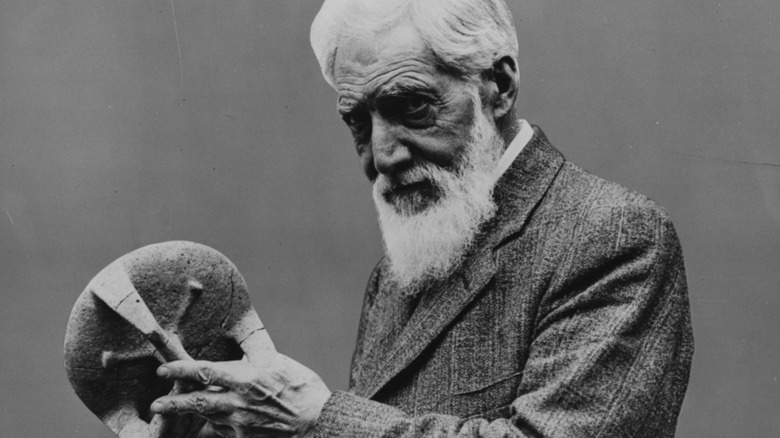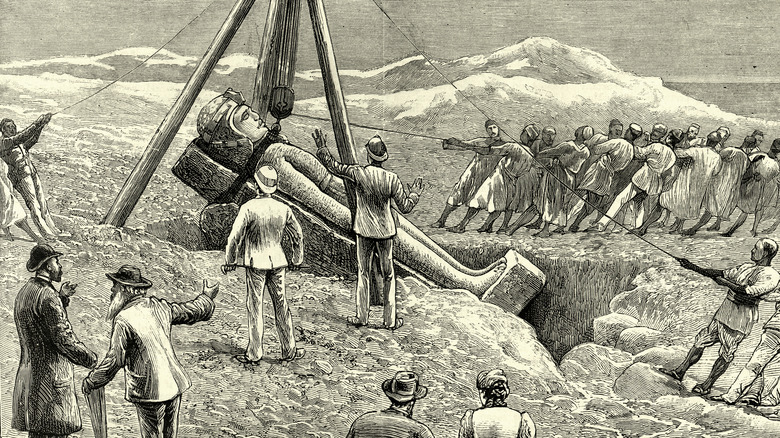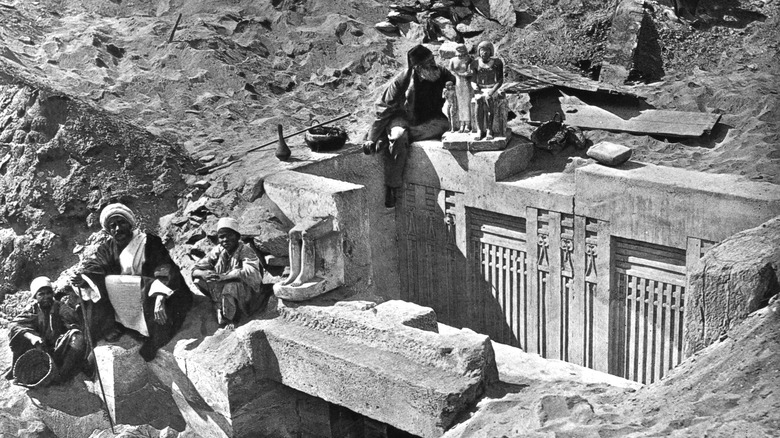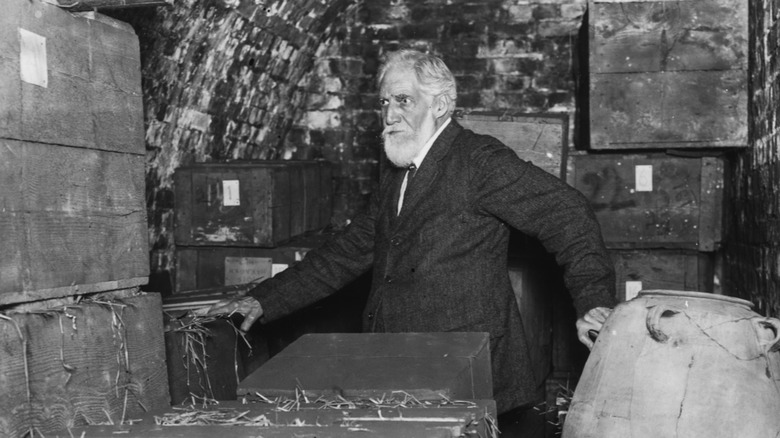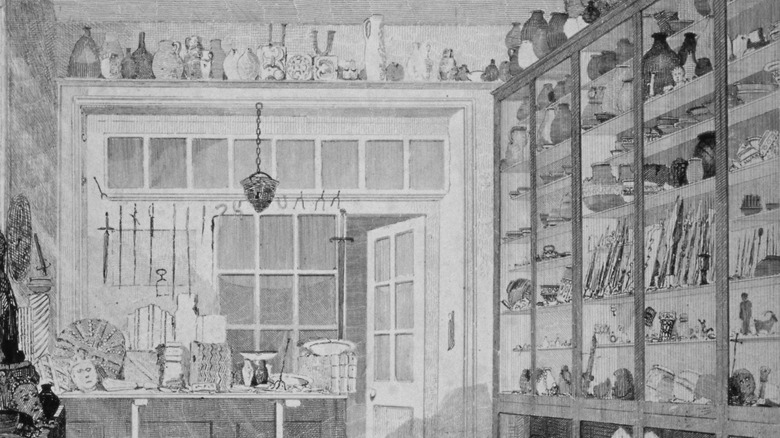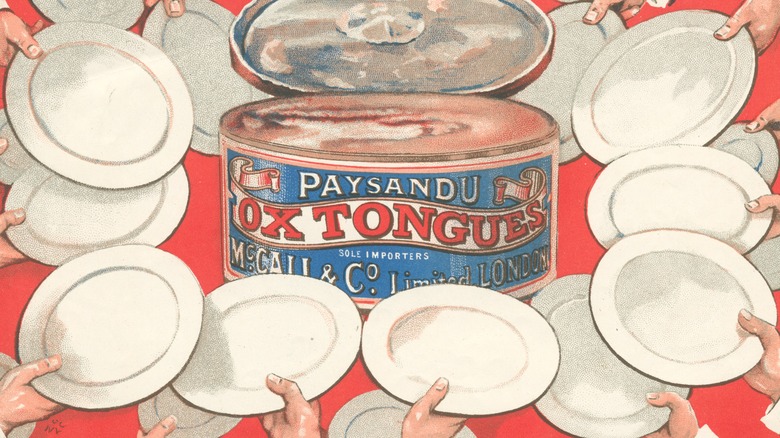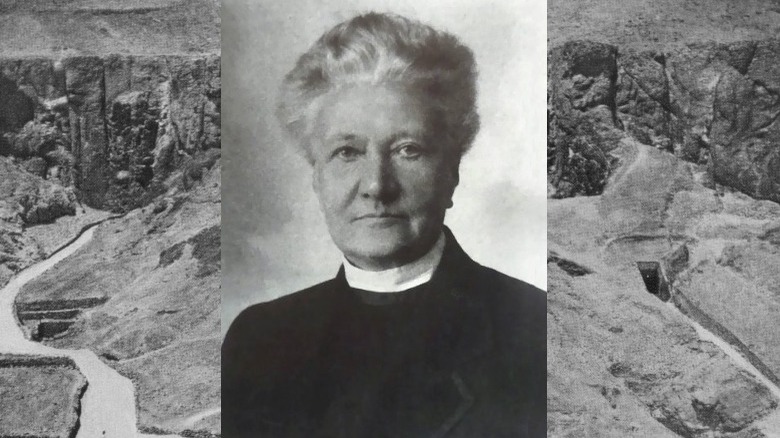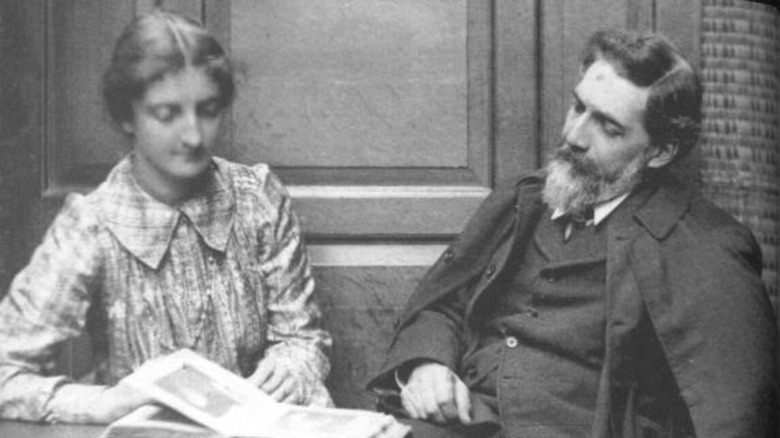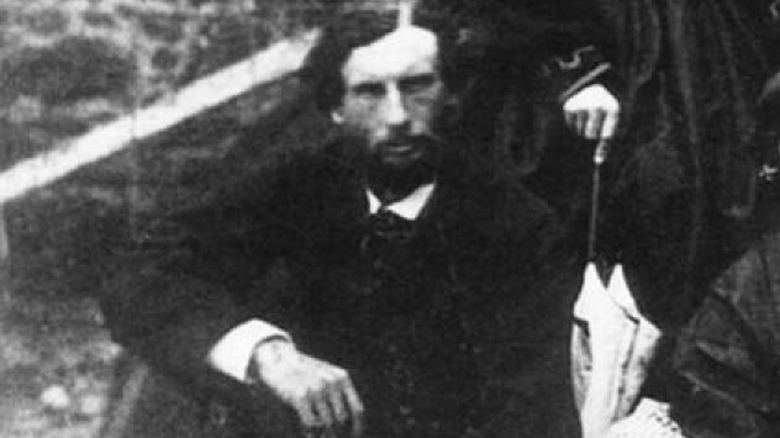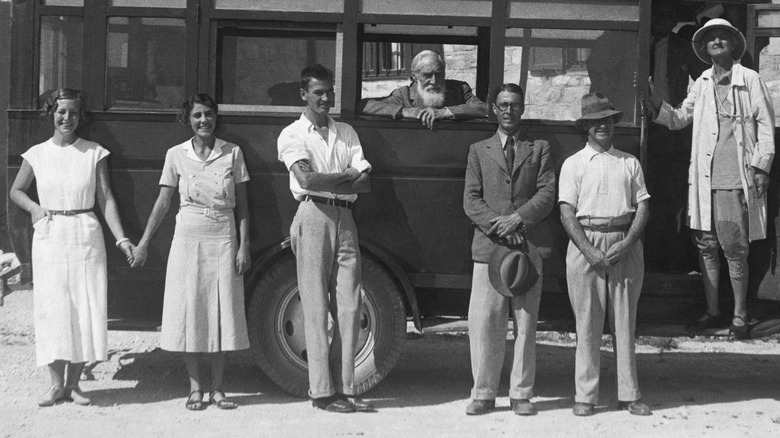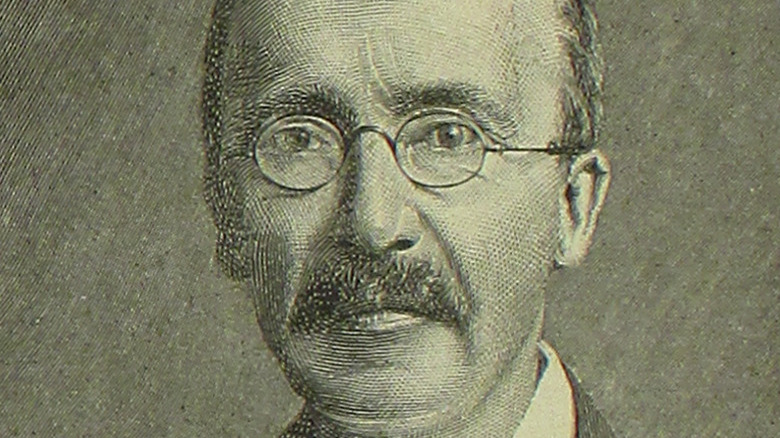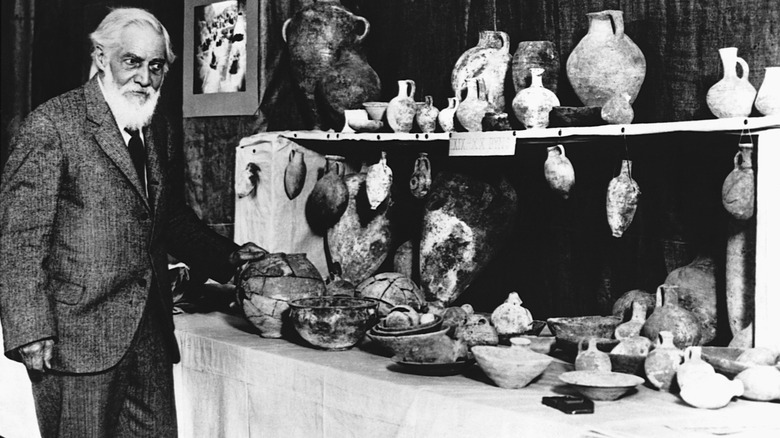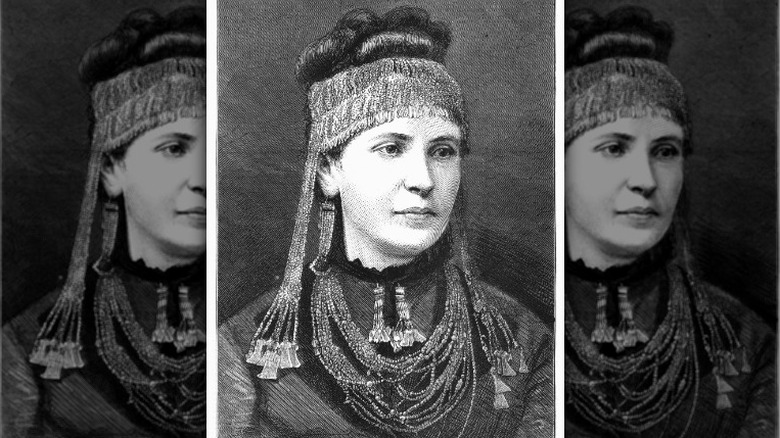What Being An Archaeologist In The 1800s Was Really Like
The 1800s was a time of innovation in science, and archaeology was undergoing a revolution. Some upper-class European gentlemen had always enjoyed searching for historical artifacts, but in the 19th century, public interest and advances in science helped to transform archaeology into a dynamic and innovative field of study. It was an exciting time to be an archaeologist, with more opportunities to travel and share their discoveries than ever before.
The 19th century brought with it an unprecedented amount of public fervor for the past that created the perfect environment for archaeologists to thrive. In 1779, soldiers in Napoleon's army stationed in the Nile Delta accidentally discovered the Rosetta Stone. Soon, scholars from England and France used this discovery to decode Ancient Egyptian hieroglyphics. What followed was an obsessive cultural phenomenon in Victorian England known as Egyptomania. The field of archaeology transformed and the field of Egyptology emerged at a time when all things Ancient Egypt were fashionable, popular, and fascinating.
Having ancient artifacts in their museums became a matter of national pride for powerful empires, and archaeologists, scholarly and amateur alike, were more than happy to take up the challenge – whether that meant exploring Incan ruins in Latin America, excavating ancient cities in the Ottoman Empire, or searching for pharaohs' tombs in Ancient Egypt.
Archaeologists traveled the world
While archaeology was rapidly developing into a rigorous new science in the 1800s, many archaeologists were still hobbyists, enamored with the idea of traveling to far-flung locations around the world to discover the secrets of the past. Egypt was an extremely popular destination, but European archaeologists spread out around the globe from East Asia to South America.
These archaeologists were enthusiastically attempting to learn more about the history of their destinations, but in some cases were no more educated about the culture of the places they worked than the average 19th-century tourist. In a 2011 article in the International Journal of Historical Archaeology, Matthew H. Johnson described the historic link between archaeology and tourism. Dating back to the 17th century, it was a popular pastime for wealthy scholars and aristocrats to travel Europe to see monuments and ruins of older civilizations and buy art, which naturally developed into a passion for discovering ancient artifacts. Despite this, some archaeologists of this era did not approve of travel for pure recreation. As described by Egyptologist Nicole Hansen for The Collector, the man sometimes referred to as the "Father of Archaeology" Sir Flinders Petrie was openly disdainful of travelers who relied on guides and attendants in foreign countries. Petrie himself preferred to prepare for his foreign travel expeditions as if they were camping trips, even packing a tent.
For many, it was a childhood dream
For many of the influential archaeologists in the 19th century, the dream of learning the buried history of ancient civilizations began in childhood.
Famous English archaeologist Flinders Petrie's interest in historical artifacts began when he was a child. Petrie had inherited a fascination with mineral specimens from his mother, would go surveying with his father, and began his own collection of antique rocks. His determination to make his interest a vocation was cemented when, at the age of eight, he heard adults discussing a Roman villa that had been discovered. The way they described the excavation struck the young boy as careless, and he determined that he would do a far better job.
Not all future archaeologists were as obsessed with the idea of running a meticulous dig site. The German archaeologist Heinrich Schliemånn's childhood obsession was not specifically with archaeology, but with solving an ancient mystery. Schliemånn grew up in poverty and spent much of his childhood working. At the age of seven, he became fascinated by the story of the destruction of the City of Troy, a passion that would stay with him for the rest of his life. As an adult, he was determined to track down the ruins of the ancient city.
Some archaeologists were amateurs
At this time, it was not unusual for wealthy gentlemen from Europe and North America to consider searching for artifacts to be an exciting hobby. Gentlemen with no related education often made themselves experts in interesting local sites, like the ruins of Roman monuments or medieval churches, and hired workers to dig up promising land.
Enthusiastic hobbyists searching the countryside for artifacts weren't the only people without a formal education in the field of archaeology. Some of the most respected archaeologists of the era who became pioneers in their field were actually amateurs. Flinders Petrie's education ended at the age of ten, from which point he was self-taught. As noted by The Collector, as a teenager, the British Museum considered him enough of an expert to hire him to acquire antique coins. Heinrich Schliemånn also had little formal education. He was working class and spent his youth working a variety of trades, from serving meals on a ship that wrecked near the Netherlands to bookkeeping in St. Petersburg. It wasn't until Schliemånn was in his 40s that he was able to devote himself to his true passion: archaeology.
Archaeologists had their own scholarly societies
It could be difficult for archaeologists in the 1800s to secure funding and share their discoveries, particularly if they were not wealthy or formally educated. Joining an association or society devoted to archaeology created new opportunities, and at this time there were more than ever to choose from.
The British Archaeological Association was founded in 1843 by scholars Thomas Wright, Thomas Joseph Pettigrew, and Charles Roach Smith. The association came at the perfect moment when archaeology was at its most popular and was soon populated by enthusiasts. While it had long been a pastime of wealthy gentlemen, the BAA and Smith, in particular, sought to make funding and publication more achievable for people who weren't already wealthy.
More local societies for passionate enthusiasts became more common in the 1800s, too. As described by Sussex Archaeology Society's museum officer Emma O'Conner in an interview with The Past, in 1845, some construction accidentally unearthed several 11th-century caskets, and many in Sussex were suddenly overwhelmed by a new interest in the history of their local area. Three men who lived in the area drummed up interest in forming their own archaeology society.
Some brought food from home – but shouldn't have
While some archaeologists preferred to dig into local history, many more went abroad. For many, the opportunity to travel around the world learning about the history of faraway places was one of the best parts of their vocation, but others missed the familiar comforts of home. As noted in a journal article from The Classical World, the German archaeologist Heinrich Schliemånn's diary is full of complaints about the local Ottoman food, like rice, peppers, and tortoise meat. British Egyptologist Flinders Petrie preferred bringing food from England on his expeditions to trying the local food, but as detailed by The Collector, this was often a mistake.
Petrie brought massive stores of canned food from England with him on his trips to Egypt. However, his excavations were long and tested the longevity of canned goods. By the time he got around to actually eating the food he brought, the cans might have been sitting in the hot Egyptian sun for years. The frugal Petrie was unwilling to throw them out unless they burst when thrown at a wall, however, and routinely ate the old food. As noted by National Museums Scotland, other archaeologists who came to Egypt to work with Petrie and had less strong stomachs often came down with food poisoning.
It was difficult for women to get respect as archaeologists
Archaeology had long been a respectable hobby for European gentlemen, but for women, it was almost unheard of. In the 1800s, women like Janet Agnes Gourlay, Kate Bradbury, Margaret Alice Murray, and Margaret Benson did become archaeologists and make important contributions to the developing field, but there were a lot of things standing in their way. It wasn't easy for any aspiring archaeologist to secure funding, hire assistants, and begin excavating a promising site, but for women, there were people actively trying to keep them from achieving their goals.
Most archaeological societies would not allow women to join and would work to undermine any discoveries that their female colleagues managed to publish without their help. As described by History, Maud Cunnington, who would famously go on to excavate Woodhenge with her husband, warned women that sexism made it "far too difficult" to enter archaeology.
Mary Brodrick traveled to Egypt in 1888 and developed a fascination with the history of the ancient empire that had once thrived there. As described by UWM Anthropology, as soon as she returned to England she attempted to enroll in a program to study archaeology and Egyptology but was rejected because of her gender. Ultimately, Broderick had to directly petition a professor to advocate for her at the Sorbonne to begin her education. She would go on to become a tremendously successful and prolific Egyptologist, both working on dig sites in Egypt and later doing vital research and translation.
Some archaeologists were a husband and wife team
When a European or American gentleman went overseas in hopes of discovering ancient buried cities, it was considered respectable to bring his wife. Many of the women who went to their husbands' excavations ended up having a much more significant role than being present to protect their husbands from scandal. As described in Norma Denver's 2004 article in Near Eastern Archaeology, in many cases, the achievements of famous archaeologists of this era would not have been possible without the assistance of their wives, while these women were not given credit for their successes, or even recognized as archaeologists in their own right.
Sir Flinders Petrie credited his wife Hilda Petrie in the dedication of his book "Seventy Years in Archaeology," with "To My Wife on whose toil most of my work depended." Hilda Petrie worked to secure funding for her husband's work, personally oversaw his excavations and managed the workers on the dig site, and kept detailed records for publication.
Some women who worked alongside their husbands were already interested in archaeology before their marriage. Petrie also trained women scholars in Egyptology, like Scottish archaeologist Annie Pirie, whose skill as an illustrator allowed her to carefully document artifacts discovered during excavation. She happened to get food poisoning (likely from Petrie's tainted canned food) at the same time as fellow archaeologist James Quibell, causing them to spend a significant amount of time together. Soon after, they married and continued to work together.
It was expensive
Between 1857 and 1864, methodical archaeologist Frank Calvert acquired land which he believed might contain the ruins of the ancient city of Troy. There was only one thing standing between him and a tremendously successful excavation: money.
Calvert's dilemma was not at all unusual for 1800s archaeologists. Overseas excavations were extremely long and expensive and required serious funding to be possible. Such vast sums of money were only available to upper-class gentlemen with the advantages of living in a vast and powerful empire. Even with all of these advantages, it was extremely difficult to find donors. Once funding was secured, archaeologists had to work with their patrons. These were sometimes individuals and sometimes institutions, but either way, their donors were usually entitled to at least some of the discoveries that they had helped to pay for. Depending on who those patrons were, this could lead to conflict.
Frank Calvert did not have the funding to search for Troy. As described in a review published by BMCR of Marcelle Robinson's "Schliemånn's Silent Partner, Frank Calvert," the high cost of excavating the site forced Calvert to turn to wealthy amateur archaeologist Heinrich Schliemånn. The two had a fraught relationship which only worsened as they found more artifacts of value. Schliemånn removed any mention of Calvert's contributions when he published their findings, essentially cutting him out of the history of the discovery of Troy.
There was often conflict
Archaeologists in the 1800s often worked overseas, and there could sometimes be conflicts with the people who lived near their dig sites. Often, these were cultural conflicts, with simmering distrust on both sides. These could have ramifications decades after. Famously, in Qrna, Egypt several incidents of looting by locals in order to sell artifacts to European enthusiasts in the 1800s were used as an excuse to force their descendants out of their homes over a century later, making it easier to excavate the tombs below. Sometimes, however, these conflicts had immediate consequences. archaeologists working in the 19th century sometimes found their work directly threatened or even destroyed because of conflicts with the people living near their excavations.
On one occasion, detailed by Egyptologist Nicole B. Hansen for The Collector, tourists visiting Egypt were so eager to see the excavation that Flinders Petrie was working on that they trampled the crops of a farmer who lived near the dig site, doing irreparable damage. In retribution, the farmer completely destroyed the structure which Petrie and his team were carefully excavating.
They weren't always careful
Archaeology was still developing as a field at this time, which meant that there weren't as many established rules for how to properly excavate, and many of the leading archaeologists of the day were not professionally trained. The market for artifacts from ancient empires was at its height, meaning that there was a lot of potential money and fame at stake. Meanwhile, every year that an excavation went on was incredibly expensive. There was a significant incentive for archaeologists to work quickly rather than carefully. The worst offender was almost certainly Heinrich Schliemånn.
When Schliemånn took over the excavation of the region he and Frank Calvert believed to have been the site of the ancient city of Troy in 1870, he didn't find very much. As described in Lapham's Quarterly, by 1872 he was out of patience. He ordered his team of workers to dig an enormous trench. Calvert attempted to stop Schliemånn, but Schliemånn wasn't interested in being cautious. He and his team did discover Troy, one of the most significant archaeological discoveries of the age, but in their haste, they also obliterated a massive amount of what they were looking for. It's unknown how many vital historical artifacts were destroyed.
They had to develop new methods, which often included a lot of guesswork
The 1800s was an era of scientific advancement, and this new knowledge helped archaeologists to understand their craft better than any before them. In particular, a greater understanding of evolution revolutionized the way that archaeologists of the 19th century thought about mankind's development, and advancement in the field of geology made it possible to guess what era different artifacts they discovered might be from. However, archaeology was still developing as a science, and archaeologists were forced to come up with many of their own methods for understanding their findings. Without modern tools, they often had to rely on guesswork.
In modern times, techniques like radiocarbon dating are typically used to determine the age of an artifact, but in the 1800s, archaeologists had to come up with other strategies for figuring out how old the things they discovered were. As described in The Collector, Flinders Petrie discovered over 900 graves in a region of Egypt. In order to approximate when each individual had died, Petrie compared the pottery he had found on each grave. Rather than trying to blindly guess the ages of the items he saw, he recognized the changes in the way the pottery had been made and the styles that had been chosen to estimate when they, and the graves, had been created. This technique, which Petrie is credited with developing, is known as "sequence dating," and was one of the most popular methods among archaeologists in the 19th century.
Sometimes, they were looters
One of the most iconic images to come out of 1800s archaeology is a photograph of Heinrich Schliemånn's wife Sophia wearing a massive amount of jewelry that they had unearthed while excavating Troy. The magnificent diadem and golden jewelry Sophia was wearing were stolen treasures. As soon as the artifacts that he dubbed "Priam's Treasure" were found, Schliemånn hid them with his personal possessions. When a Turkish government official asked to see the artifacts he had found, he refused, leading to a fight. Schliemånn quickly packed up the artifacts and smuggled them away from the dig site and to his home in Greece.
While Schliemånn's case was particularly egregious, many archaeologists of the 19th century working outside their home countries were regularly taking items that had significant cultural value away from the places they had been found to be sold to collectors or displayed in foreign museums. In recent years, there has been a push to return some of these stolen artifacts.
